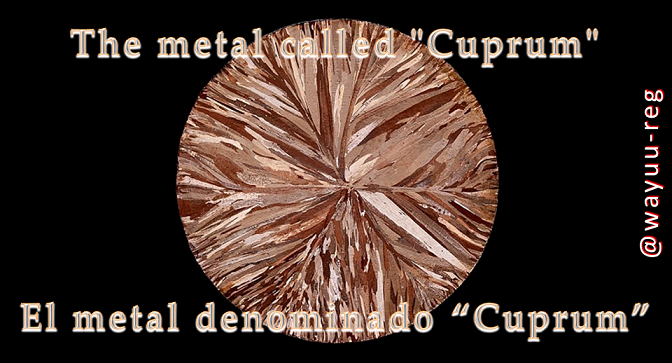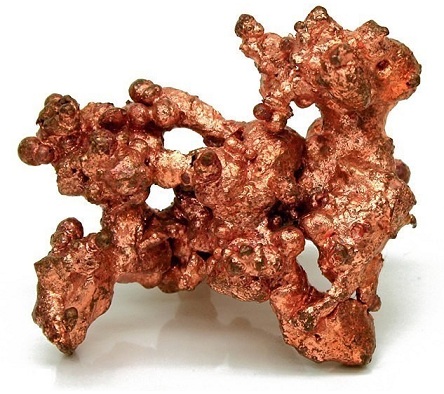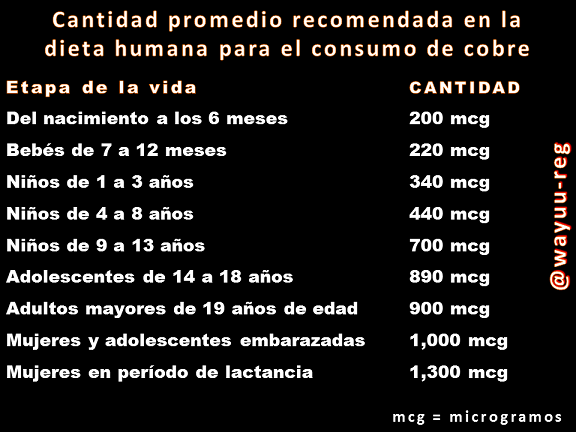
Copper disc - Disco de cobre
"Continuous casting copper disc (99.95% pure), macro etched, ∅ ≈83 mm"
"Disco de cobre de colada continua (99,95% de pureza), macrograbado, ∅ ≈83 mm"
When "Cuprum" is mentioned, we are referring to the metal of red-brown color, bright, very malleable and ductile; which appears in the Periodic Table with the symbol Cu, its density is 9.94 and the atomic number is 29; atomic weight 63.54 and it melts at 1083°C, it also boils at 2300°C. It is commonly known as copper:
Cuando se menciona el “Cuprum” se está refiriendo al metal de color rojo pardo, brillante, muy maleable y dúctil; el cual se manifiesta en la Tabla Periódica con el símbolo Cu, su densidad es 9,94 y el número atómico es 29; peso atómico 63,54 y se funde a 1083°C, también hierve a 2300°C. Comúnmente se le conoce con el nombre de Cobre:
“Copper (from the Latin cuprum, from the Greek kypros, Cyprus), whose symbol is Cu, is the chemical element with atomic number 29. It is a copper-colored transition metal, i.e. reddish-orange, with a metallic luster, which, together with silver, gold and roentgenium, is part of the so-called copper family. It is one of the best conductors of electricity (second only to silver). Its high electrical conductivity, ductility and malleability, it is the most widely used material for manufacturing electrical cables and other electrical elements and electronic components…” ✱ Copper
“El cobre (del latín cuprum, y este del griego kypros, Chipre), cuyo símbolo es Cu, es el elemento químico de número atómico 29. Se trata de un metal de transición de color cobrizo, es decir, rojizo anaranjado, de brillo metálico que, junto con la plata, el oro y el roentgenio, forma parte de la llamada familia del cobre. Es uno de los mejores conductores de electricidad (el segundo después de la plata). Gracias a su alta conductividad eléctrica, su ductilidad y su maleabilidad, es el material más utilizado para fabricar cables eléctricos y otros elementos eléctricos y componentes electrónicos…” ✱ Cobre
.jpg)
Copper (metal) - Cobre (metal)
"Native copper macro about 1½ inches (4 cm) in size"
"La macro del cobre nativo cerca de 1½ avanza a poquitos (4 centímetros) de tamaño"
The chemical properties of copper are that it is a transition element of the ɪ subgroup of the periodic classification, like silver and gold. It oxidizes little at ordinary temperature and in dry open air; it is coated with Cardenillo (basic carbonate) in humid air and in the presence of carbon dioxide. It is a reducer. Its oxygenated compounds are:
a) Cuprous oxide, OCu2, obtained by reduction of (HO)2Cu hydroxide, of a beautiful red color (ceramics, vitraux, red glasses) and insoluble in alkalis.
b) Cupric oxide, OCu, black in color, which comes from the hot oxidation of copper, used in the analysis of organic compounds.
c) Copper sulfate, SO4Cu, is a blue vitriol, obtained by direct action of sulfuric acid on the metal or by roasting copper pyrites. It is the most important Copper Salt (sulfate) most important (electrolytic refining of copper, copper plating, etc.). When heated, it loses its blue color, which it immediately recovers on contact with humid air. Its solution in water with soda and tartaric acid is Fehling's Liquor (reagent), with which glucose in urine is revealed and dosed (in diabetic patients).
d) Copper nitrate, (NO3)2Cu, formed by the direct cold action of nitric acid on the metal.
Las propiedades químicas del cobre radican en que es un elemento de transición del subgrupo ɪ de la clasificación periódica, como la plata y el oro. Se oxida poco a una temperatura ordinaria y al aire libre seco; se recubre de Cardenillo (carbonato básico) al aire húmedo y en presencia de anhídrido carbónico. Es un reductor. Sus compuestos oxigenados son:
a) Óxido Cuproso, OCu2, obtenido por reducción del hidróxido (HO)2Cu, de un hermoso color rojo (cerámica, vitraux, vidrios rojos) e insolubles en los álcalis.
b) Óxido Cúprico, OCu, de color negro, que proviene de la oxidación del cobre en caliente, utilizado en el análisis de los compuestos orgánicos.
c) Sulfato de Cobre, SO4Cu, es un vitriolo azul, obtenido por acción directa del ácido sulfúrico sobre el metal o por tostadura de las piritas cuprosas. Es la Sal de Cobre (Sulfato) más importante (refinamiento electrolítico del cobre, cobreado, etc.). Al calentarse pierde su color azul, que recupera en seguida al contacto con el aire húmedo. Su solución en agua adicionada de soda y de ácido tartárico es el Licor de Fehling (reactivo), con el cual se revela y se dosa la glucosa de la orina (en pacientes diabéticos).
d) Nitrato de Cobre, (NO3)2Cu, formado por acción directa y en frío del ácido nítrico sobre el metal.
The non-oxygenated compounds of copper are the following:
(a) Cuprous chloride, ClCu, which has the property of absorbing carbon oxide (gas analysis).
b) Cupric chloride, Cl2Cu, anhydrous (yellow) or crystallized (greenish), used as a catalyst (Deacon Procedure).
The action of nitric acid is the one that best attacks copper. This property is used in copper engraving (artistic engraving, reproduction of photographs, drawings, etc.).
Los compuestos no oxigenados del cobre son los siguientes:
a) Cloruro Cuproso, ClCu, que tiene la propiedad de absorber el óxido de carbono (análisis del gas)
b) Cloruro Cúprico, Cl2Cu, anhidro (amarillo) o cristalizado (verdoso), utilizado como catalizador (procedimiento Deacon).
La acción del ácido nítrico es el que mejor ataca al cobre. Se utiliza esta propiedad en el grabado sobre cobre (grabado artístico, reproducción de fotografías, de dibujos, etc.).
Copper ores are extremely varied, since copper exists as oxides, sulfides, carbonates, sulfates, alone or often, with iron, arsenic, lead, silver, etc. Native copper is either crystallized (cubic system) or in amorphous, rounded masses (Ural Mountains, Russia). Oxidized copper (cuprite, OCu2) is a red glassy stone (Andes Mountains, Chile); Melaconite (Tenorite) is black cupric oxide (Lake Superior, USA-Canada). Chalcocite, SCu2, or copper pyrite, crystallized in very small crystals called "Peru Sand". The other copper pyrites are known as Chalcopyrite (yellow), SCu2, S3Fe2, of Panabase (gray copper). The carbonates are Azurite (blue) and Malachite (green). Phosphates are Alferesa (green), Pseudo-malachite. Arsenates and silicates are quite rare.
Los minerales de cobre son extremadamente variados, ya que el cobre existe en estado de óxidos, de sulfuros, de carbonatos, de sulfatos, solo o menudo, con hierro, el arsénico, el plomo, la plata, etc. El cobre nativo está, o bién cristalizado (sistema cúbico) o en masas amorfas y redondeadas (Montes Urales, Rusia). El cobre oxidado (cuprita, OCu2) es una piedra vítrea roja (Cordillera Los Andes, Chile); la Melaconita (Tenorita) es el óxido cúprico negro (Lago Superior, USA-Canadá). La Calcosina, SCu2, o pirita de cobre, cristalizada en cristales muy pequeños llamados “Arena del Perú”. Las otras piritas de cobre se conocen con los nombres de Calcopirita (amarilla), SCu2, S3Fe2, de Panabasa (cobre gris). Los carbonatos son de Azurita (azul) y la Malaquita (verde). Los fosfatos son la Alferesa (verde), la Pseudo-malaquita. Los arseniatos y los silicatos son bastante raros.
In copper metallurgy, the sulfides are roasted in an oxidizing flame, in which the iron, if present, is oxidized very rapidly. What remains (matte) is treated in an apparatus analogous to the Bessemer converter, in which the combined action of infiltrated air and silica causes the iron to pass to the silicate state (slag), but oxidizes part of the copper; this oxide is reduced by the copper sulfate in the matte. The ores are also treated by humid air and iron and copper sulfates are obtained (wet process). The copper sulfate is then dissociated by immersing iron sheets (iron replaces copper); but it is generally preferred to extract copper from its salt by electrolysis.
Dentro de la metalurgia del cobre los sulfuros se tuestan en la llama oxidante, con la cual el hierro, si lo hay, se oxida muy rápidamente. Lo que resta (mata) se trata en un aparato análogo al convertidor Bessemer, en el cual la acción combinada del aire infiltrado y de la sílice hace pasar el hierro al estado de silicato (escorias), pero oxida una parte del cobre; este óxido se reduce por el sulfato de cobre de la mata. Los minerales se tratan igualmente por aire húmedo y se obtienen sulfatos de hierro y de cobre (vía húmeda). Se disocia en seguida el sulfato de cobre sumergiendo láminas de hierro (el hierro sustituye el cobre); pero se prefiere generalmente extraer el cobre de su sal por electrólisis.
The electrical industry uses a large amount of copper (wires of different thicknesses, electrodes). The industry in general uses it in the form of different alloys: Brass or yellow copper (copper + zinc), Bronze (copper + tin and also copper + nickel or + aluminum, etc.), Duralumin, etc. Copper and beryllium alloys are very hard.
La industria eléctrica utiliza gran cantidad de cobre (hilos de diferente grosor, electrodos). La industria en general lo emplea bajo la forma de distintas aleaciones: Latón o cobre amarillo (cobre + zinc), Bronce (cobre + estaño y también cobre + níquel o + aluminio, etc.), Duraluminio, etc. Las aleaciones de cobre y berilio son muy duras.
As for the human diet, one of the various Trace element is the mineral copper, which is necessary for the healthy maintenance of animals and plants. The human organism uses copper to process several fundamental functions, such as: to manufacture energy, to cooperate in the production of connective tissues and blood vessels; it also supports the maintenance of the immune system and the nervous system, and activates genes. Copper is needed from an early age to develop the human brain. The average recommended daily amount required depends on the age of the individual (micrograms = mcg):
En cuanto a la dieta humana, uno de los diversos Oligoelemento es el mineral de cobre, el cual es menester para el mantenimiento saludable de los animales y plantas. El organismo de los seres humanos utiliza el cobre para procesar diversas funciones fundamentales, tales como: fabricar energía, coopera en la producción de tejidos conectivos y vasos sanguíneos; además, apoya el mantenimiento del sistema inmunitario y el sistema nervioso, también activa los genes. Para desarrollar el cerebro humano se necesita el cobre desde temprana edad. La cantidad promedio recomendada que requiere a diario depende de la edad del individuo (microgramos = mcg):

Average comparative table - Cuadro promedio comparativo
The recommended portions can be consumed in a wide variety of foods, since many contain it naturally: proteins such as beef liver, seafood such as oysters, seeds such as sesame and sunflower seeds, nuts such as cashews, natural chocolate, whole wheat products such as wheat bran, also in mushrooms, potatoes, chickpeas, avocados, etc.
Se puede consumir las porciones recomendadas dentro de una gran variedad de alimentos, ya que muchos lo contienen de forma natural: proteínas como el hígado de res, mariscos como las ostras, semillas como el sésamo y girasol, en las nueces como anacardos, el chocolate natural, productos integrales como salvado de trigo, también en los champiñones, papas, garbanzos, aguacates, etc.
There are several multimineral-multivitamin supplements that contain copper in their formula. Very often, copper is presented in these dietary supplements under the names: copper amino acid chelate, cupric oxide, copper gluconate and cupric sulfate; where it is not known if one form or commercial presentation is better than another.
Existen variados suplementos multiminerales-multivitamínicos que contienen cobre en su fórmula. Muy a menudo, se presenta el cobre en estos complementos dietéticos con los nombres: quelato de aminoácido de cobre, óxido cúprico, gluconato de cobre y sulfato cúprico; en donde se desconoce si una forma o presentación comercial es mejor que otra.
There are many human beings who manage to obtain sufficient copper intake during the day, by consuming healthy and balanced food. However, there is a minority who are severely impaired in getting enough copper, such as patients with genetic disorders called Menkes (rare), also in Wilson's disease, other people who suffer from copper deficiency due to high zinc intake, which can create interference in the ability to absorb copper.
Son muchos seres humanos que logran obtener la suficiente ingesta de cobre durante el día, al consumir alimentos sanos y balanceados. Sin embargo, existe una minoría con gran impedimento para ingerir suficiente cobre, como los pacientes con trastornos genéticos denominado Menkes (es poco común), también en la enfermedad de Wilson, otras personas que padecen deficiencia de cobre por el alto consumo de zinc, lo cual puede crear interferencia en la capacidad de absorción del cobre.
All human beings should seek to obtain mineral nutrients (trace elements) naturally, such as iron, zinc, magnesium, calcium, phosphorus, sodium, potassium, copper, among others; that is, by ingesting drinks and foods with the daily diet, which help regulate the metabolism without the additional consumption of some "artificial" drug, which could cause addiction or increase too much the level needed for your body.
Todos los seres humanos deberían buscar obtener los nutrientes minerales (oligoelementos) de manera natural, como el hierro, zinc, magnesio, calcio, fósforo, sodio, potasio, cobre, entre otros; es decir, ingiriendo bebidas y alimentos con la dieta diaria, que le ayudan a regular el metabolismo sin el consumo adicional de algún fármaco “artificial”, el cual podría causar adicción o incrementar demasiado el nivel necesitado para su organismo.
Thank you very much
for your kind attention !
Remember that to donate
blood is to save many lives.
¡ Muchísimas gracias
por su amable atención !
Recuerde que donar sangre
es salvar muchas vidas.
@wayuu-reg
This research is offered with the purpose that all this information becomes an integral part of your daily knowledge and contributes to improve, even more, your quality of life: healthy and preventive.
Esta investigación es ofrecida con la finalidad de que toda esta información forme parte integral de su conocimiento habitual y contribuya a mejorar, aún más, su calidad de vida: saludable y preventiva.
BIBLIOGRAPHIC QUERIES ✱ CONSULTAS BIBLIOGRÁFICAS
✱Copper - Cobre
✱Copper - Cobre
✱Copper chemical properties - Propiedades químicas del cobre
✱ All images in this publication are in the public domain (CC0)
✱ The GIF image, with personal photos, was edited with the online application Picasion.com
✱ The translation was made by DeepL
I would be very pleased to receive your valuable comments and constructive suggestions on the topic presented, as they will be considerable for the improvement of future publications
T H A N K !
✱ Todas las imágenes de esta publicación son de dominio público (CC0)
✱ La imagen GIF, con fotografías personales, fue editada con la aplicación en línea Picasion.com
✱ La traducción fue realizada por DeepL
Me sentiría muy complacida en recibir su valioso comentario y constructivas sugerencias acerca del tema presentado, ya que serán considerables para el mejoramiento de las futuras publicaciones
¡ G R A C I A S !

The rewards earned on this comment will go directly to the people( @elisaday7 ) sharing the post on Twitter as long as they are registered with @poshtoken. Sign up at https://hiveposh.com.
Así que el mineral de cobre también se puede ingerir como parte de la dieta humana. Que bien eso, no lo había pensado. Saludos @wayuu-reg TQM
Muchísimas gracias mi linda niña. Yo también TQM
Congratulations @wayuu-reg! You have completed the following achievement on the Hive blockchain And have been rewarded with New badge(s)
Your next target is to reach 5000 upvotes.
You can view your badges on your board and compare yourself to others in the Ranking
If you no longer want to receive notifications, reply to this comment with the word
STOPTo support your work, I also upvoted your post!
Check out our last posts:
Support the HiveBuzz project. Vote for our proposal!
Es una buena investigación. Siempre es bueno aprender nuevos conocimientos que nos permiten conocer hasta de que el mineral "cuprum" es en realidad el cobre en idioma latín. Buen trabajo @wayuu-reg
Wow , that was informative, does this metal get faded or loses its properties over time ?
Thanks for your contribution to the STEMsocial community. Feel free to join us on discord to get to know the rest of us!
Please consider delegating to the @stemsocial account (85% of the curation rewards are returned).
You may also include @stemsocial as a beneficiary of the rewards of this post to get a stronger support.
¡Felicitaciones!
1. Invierte en el PROYECTO ENTROPÍA y recibe ganancias semanalmente. Entra aquí para más información.
3. Suscríbete a nuestra COMUNIDADEntra aquí para más información sobre nuestro trail., apoya al trail de @Entropia y así podrás ganar recompensas de curación de forma automática.
4. Creación de cuentas nuevas de Hive aquí.
5. Visita nuestro canal de Youtube.
Atentamente
El equipo de curación del PROYECTO ENTROPÍA
Thank you so much @wayuu-reg for this very interesting and informative post or thread on copper which lets us know about all steps from the element od the Mendeleiev table to the diet via its different uses and how, from metallurgy to its components and its virtues for health, best+!
I thank you for supporting my research work. Thank you very much!
Greetings @sumotori
Le las gracias a usted por apoyar mi trabajo de investigación. Muchisimas gracias!